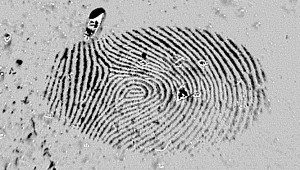
Ninhydrin is a chemical compound which proves the presence of amino acids and specific proteins. When Ninhydrin gets in contact with those substances, it reacts with creating a blue violet-red brownish colorant which makes them visible. The product of this blue violet reaction was described by Ruhemann in 1911 for the first time. Thus, it refers to the name of “Ruhemanns Purpur”.
Fingerprints mainly consist of sweat residues and include proteins. With the existence of amino acids in our sweat and hence in our fingerprints, it is possible to make latent prints visible with Ninhydrin. Therefore, the application of Ninhydrin plays an important role in the collection of evidence.
This frequently adopted process requires a 2% solution of Ninhydrin mixed with an organic solvent (usually acetone) and further supplements, like acetic acid. This mixture is applied to the relevant spots. However, this method works with porous (i.e. paper, cardboard, newspaper) and non-porous surfaces, like glass and plastic.
After the Ninhydrin had dried on the exhibit for a few minutes, it should be hung up freely in a closed container for about 48h to allow its complete development (complete reaction). Warming up the exhibit speeds up this process. However, this might cause worse results because the fingerprints may be more blurry.
Ninhydrin is known as one of the best processes to make latent fingerprints visible on porous surfaces, especially older ones. However, its power comes with a few disadvantages.
One argument is its higher total cost of processing when compared to other latent print treatments. Furthermore, it has various toxic effects on mammals. In addition, some studies show that Ninhydrin acts as a strong stage 1 tumor promoter. These are some of the reasons why the treated exhibit should always be stored and carried in special protective envelopes. Also, unprocessed ninhydrin stays on the exhibit, which might cause new fingerprints in case of careless handling, which are only seen days later.
After the latent prints have been successfully detected via the Ninhydrin method, EVISCAN can be used for further analysis: High quality pictures can be taken and made available digitally. The built in image enhancement can be applied for further analysis, and custom fit reports can be composed.



